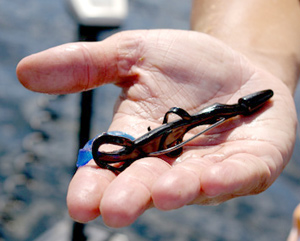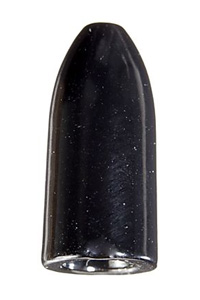
When it comes to fishing plastic worms, craws or lizards, a weight is necessary to get your presentation down to the level of the fish, and smack dab in their strike zone. Unless specifically utilizing weightless baits, worm weights are the only option for negating buoyancy, while garnering the desired effect. Rigging up can be a simple chore, yet deciding on the variation and style of weight can be a bit bewildering. Here are some options to consider.
The Basics of the Worm Fishing Weight
 |
| A Bullet-Lock fishing weight allows the weight to be "clipped" on to the eye of the hook, allowing for a snug fit and slip-free presentation. |
Simply put, a worm weight resembles a bullet. Cylindrical in shape, they are narrower at one end and widen out at the base. The base is designed to have the "head" of your plastic bait pushed up to and against, with the majority offering a concave feature for a snug fit. The narrow end is composed of a rounded point, as this allows it to slide and fall easily through any vegetation it may come in contact with.
What you end up having is an aerodynamically shaped presentation — one that can be used in any cover, without the danger of getting snagged.
Lead has always been the staple metal during manufacturing. This has changed as of late, as tungsten has entered the scene, offering a smaller design with equal weight. (This was also brought about as an alternative, due to recently proposed lead bans in certain parts of North America.)
The Good Old Standard Fishing Weight
The basic worm weight has been around for years. It is simple, yet also effective. Although they may not be as slick as the newer models on the market, they are definitely cost-effective, offering up the best value for money.
Rigging these weights is when the primitive design comes to light, as a wooden toothpick becomes part of the equation in order to make it work. After sliding your weight on your line, tying the hook and rigging your plastic, a toothpick needs to be inserted into the narrow part of the weight and broken off. This will hold the weight snug against the plastic bait, essentially stopping it from sliding up and down your line.
Many anglers have used this design for years and feel comfortable with it, although many of the newer designs do offer a simplified and easier approach.
Screw-In Fishing Weights
Similar in appearance to the standard model, the only difference is the "straw-type" appendage protruding from the base, and the thin metal wire wrapped around it in a corkscrew configuration.
Instead of using a toothpick to keep the worm weight in place, this model relies on the angler to literally screw the weight into the top end of the plastic bait. No muss and no fuss, and you are left with a tight fitting anchoring system — keeping your weight in place for good.
 |
| Tungsten fishing weights are smaller but comparable to other weights. |
This design is on the high-end when it comes to price, but the ease of use and slick design is well worth the money in my mind. (Plus, you can save those toothpicks for getting the fish out of your teeth after a hearty shore lunch!)
Peg Worm Weights
Similar to the screw-in design, this weight incorporates two hooked prongs that protrude from the base. For this design to work, it is simply a matter of rigging up your weight, hook and worm in the regular manner, then sliding the prongs into the head of the plastic and giving it a slight twist. Voila! No more sliding weight.
The holding power is good on these weights, and the hooked prongs certainly seem to lock in place and resist movement.
Bullet-Lock Weight
These weights are guaranteed not to budge, as the design allows the weight to be "clipped" on to the eye of the hook, allowing for a snug fit and slip-free presentation. Very slick idea, and one that is much different from most of the rest.
Slide the weight onto your line, clip to the hook and rig your bait as you normally would. It doesn't get much easier than this.
Tungsten Fishing Weights
Touted as "half the size of comparable lead weights," tungsten is making a splash in the fishing world. Anglers can now use weights that are dramatically smaller than their counterparts, allowing for a more compact presentation.
For those areas that are under a lead ban, tungsten is the route to go. They are also great for those that are afraid of lead poisoning, especially when dealing with younger children.
Due to being a harder material, the noise these weights transmit when making contact with structure can be up to two times as loud.
At the present moment, this design is only available in the standard model, meaning the toothpick method of holding the weight in place must still be used. Chances are this will change in the future, and better designs will undoubtedly come along.
Standard Color for Worm Weights
The standard color for worm weights is natural lead. This will be the least expensive, and for the most part, will work perfectly well.
 |
| Many anglers choose a black-colored weight, but the jury is still out on whether this slight variation makes much of a difference. |
Other options are a painted head, usually in black. Many anglers choose this color, but the jury is still out on whether this slight variation makes much of a difference. Perhaps in extremely clear water, the brightness of the natural lead may spook some fish. Hard to say really.
If you don't want to be handling the lead at all, choose those that are painted, as this will minimize the lead-to-skin contact.
Some manufacturers are also producing weights that are more colorful. Red seems to be a popular color, and can certainly be a positive when dealing with extremely murky water.
Fishing Worm Weights with Internal Rattles
Some worm weights on the market come standard with internal rattle chambers. These give another option to those anglers that are looking to attract fish with sound, and it also does away with separate rattles that are used inside the plastics themselves.
Again, any of these perks will increase price, but I can vouch for rattling worm weights, as they have increased my fishing success significantly in the past.
As you can see, worm weights are a necessity when fishing with certain plastic baits. They are part and parcel of the rigging process, and will help put more largemouth in the boat for sure. Whether it is the standard model or the premier, they will all catch fish. But like anything in fishing, some designs are certainly more intriguing, and beneficial, than others.
- 25827 views

